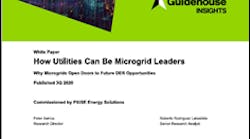Welcome to the Microgrid Knowledge Dictionary of Energy Acronyms and Definitions. We have created this page to help those new to microgrids and distributed energy resources (DERs) get up to speed quickly.
We see this dictionary as a living document that will be updated frequently. Those who work in energy know that the field has no shortage of acronyms — and it’s always creating new ones.
This is a community effort, so we welcome your contributions. Please post recommended acronyms, along with their meaning, in the comments section below. We appreciate your participation and promise to review suggestions regularly. We’ll add those that meet our editorial guidelines and seem most pertinent to the microgrid discussion. Please take into account that this page is meant to inform newcomers and those who are not necessarily energy insiders, so we are posting high-level definitions.
Microgrids encompass many aspects of the grid, electricity markets, and regulation, which is why we’ve included a broad range of energy terms here — language found in both retail and wholesale power markets, state and federal regulatory arenas, environmental and social forums, and engineering and technology discussions.
If you’re a newcomer to microgrids and want to dive into the topic deeper, you might also want to review our About Microgrids section. This ‘cornerstone content’ offers the following articles:
- What is a microgrid?
- Microgrid Benefits: Eight Ways a Microgrid Will Improve Your Operation…and the World
- Are Microgrids Expensive?
- History of Microgrids in the US: From Pearl Street to Plug-and-Play
- Choosing the Type of Microgrid that is Right for Your Operation
- Who Uses Microgrids and Why
- What are Non-Wires Alternatives?
- What is a Virtual Power Plant?
Thanks for visiting this page on Microgrid Knowledge. We hope you’ll find it useful and come back often. If you’d like to track the latest news about the quickly growing microgrid industry, please subscribe to our free newsletter, which we publish twice weekly. — Elisa Wood, editor-in-chief
FGC/Shutterstock.com
A
ACP -
Alternative Compliance Payment — A payment a utility or retail supplier can make in lieu of meeting renewable portfolio standards. (See RPS.)
ADMS -
Advanced distribution management system (ADMS): A collection of applications, that may include applications typically associated with an Outage Management System (OMS), a Distribution Management System (DMS) and Supervisory Control and Data Acquisition (SCADA), designed to monitor, control, and manage operations and outages of a distribution network efficiently and reliably.
Aggregator -
Manages DER and DR resources that consist of more than one source for the purpose of marketing energy and ancillary services to clients via the electric power system.
B
BESS -
Battery energy storage system — Batteries that store electricity that may be used later by the host, such as a building or home, or to provide service to the electric grid
Btu -
British thermal unit — The energy required to raise the temperature of one pound of water by one degree
back to top
C
CCA -
Community choice aggregators — Also called municipal aggregation, CCAs procure power on behalf of residents, businesses, and government entities within a community from a supplier other than the local utility. They are considered to be a form of local energy. Some CCAs employ microgrids as part of their energy mix.
C&I -
Commercial & Industrial —Frequently used to distinguish utility business customers from other classes of customers, such as residential
CSM -
Critical Services Microgrid – A local microgrid that provides energy resiliency and reliability for essential community services such as a school, hospital, town hall, police and fire stations.
back to top
D
DER -
Distributed energy resources (DER): Sources and groups of sources of electric power that are connected to the electric power system. DER includes both generators and energy storage technologies capable of exporting active power to an electric power system (EPS). An individual DER device inside a group of DER that form a system is a DER unit (DERU).
DERMS -
Distributed Energy Resource Management System — Software systems that seamlessly integrate high penetrations of solar energy and other distributed energy resources into the grid. When properly deployed, their capabilities provide multiple benefits to both utilities and their customers. An application platform designed to manage device information, monitor and enable optimization and control of DER and DR. A DERMS must be able to aggregate, simplify, optimize, and translate DER and DR functionalities. The DERMS enables the implementation of system services to the grid. Learn more.
DR -
Demand response (DR): The modification of electricity consumption by consumers for a limited time period in response to signals, incentives and/or prices. This can include the shifting, shaping, or shedding of load.
back to top
E
EaaS -
Energy as a service — A financing mechanism that removes the need for a customer to make an upfront capital investment in a microgrid. A third party owns, operates and maintains the microgrid; the customer makes regular payments for the microgrid’s services. Also known as MaaS — microgrid as a service.
EERs -
Energy efficiency resource standard — A government requirement that a certain amount of energy needs be met by energy efficiency.
back to top
F
FERC -
Federal Energy Regulatory Commission — The US federal agency that oversees the bulk power transmission grid
FTM -
Front of the meter — An energy resource located on the grid, rather than at a customer’s site; or more specifically electricity that passes through utility wires
back to top
G
GW or GWh -
Gigawatt or gigawatt-hour — A gigawatt is one billion watts. A gigawatt-hour is the work done in one hour by one billion watts
back to top
H
HVAC -
Heating Ventilation and Air Conditioning — The heating and cooling systems in a building
HVO -
Hydro vegetable oil — a renewable diesel made of vegetable oils or animal fats that can be used place of fossil-fuel diesel.
back to top
I
IRP -
Integrated resource plan — A document created by a utility that examines the future energy needs in its service territory and how it will meet them.
ISO -
Independent system operator — a regional organization in the US that manages the transmission grid. Similar to an RTO — a regional transmission organization
ISO-NE -
ISO New England — the grid operator for the six state New England region. (See ISO.)
ITC -
Investment tax credit — Often used in reference to tax credits offered by the US government for wind and solar power
back to top
J
J -
Joule — A unit of energy that describes the amount of work done on a body by one Newton force that moves the body one meter
back to top
K
kW or kWh -
Kilowatt — 1,000 watts of electrical power. A kilowatt-hour is the work done in one hour by one thousand watts
Kv -
Kilovolt — A unit that measures electrical force. Equals 1,000 volts
back to top
L
LCOE -
Levelized cost of energy — the cost per-megawatt hour of energy when taking into account construction and operation of a power plant over a specified period
LNG -
Liquified natural gas
LPG -
Liquified petroleum gas
LSE -
Load serving entity — A utility or other company that provides electricity to a customer (load).
back to top
M
MaaS -
Microgrid as a service — A financing mechanism that removes the need for a customer to make an upfront capital investment in a microgrid. A third party owns, operates, and maintains the microgrid; the customer makes regular payments for the microgrid’s services. Also known as EaaS — energy as a service.
MW or MWh -
Megawatt — one million watts. A megawatt-hour is the work done in one hour by 1 million watts of electricity
MGK -
back to top
N
NG -
Natural gas
back to top
O
O&M -
Operation and maintenance
back to top
P
PJM -
PJM Interconnection — A grid operator, or regional transmission organization (RTO), that coordinates the movement of wholesale electricity in all or parts of Delaware, Illinois, Indiana, Kentucky, Maryland, Michigan, New Jersey, North Carolina, Ohio, Pennsylvania, Tennessee, Virginia, West Virginia and the District of Columbia
PSPS -
Public safety power shutoffs — Term used by California investor-owned utilities to describe a practice of shutting off power to customers in an effort to avert wildfires caused by electrical sparks.
back to top
Q
QF -
Qualifying facility — A special class of energy facilities in the US. As defined by FERC, QFs may be small renewable power producers (80 MW or less) or cogeneration plants.
back to top
R
REC -
Renewable energy credit or certificate — a market-based instrument, representing 1 MWh of renewable electricity, typically used to show compliance with state renewable porfolio standards (RPS). A REC represents the property rights to environmental, social and other non-power attributes.
RFP/RFQ/RFI -
Request for proposals, request for qualifications, request for information
RPS -
Renewable portfolio standards — Rules set up by US states that require a certain amount of electricity come from renewable resources by a specified date. Utilities and other entities meet the requirements by procuring or creating RECs. (See RTO.)
RNG -
Renewable natural gas — A fuel derived from organic waste that can be used in place of natural gas
RTO -
Regional transmission organization — a regional organization in the US that manages the transmission grid. Similar to an ISO — an independent system operator
back to top
S
SPP -
Southwest Power Pool — A grid operator, or regional transmission organization, that serves all or part of Arkansas, Iowa, Kansas, Louisiana, Minnesota, Missouri, Montana, Nebraska, New Mexico, North Dakota, Oklahoma, South Dakota, Texas and Wyoming. (See RTO.)
back to top
T
TOU -
Time-of-use rates — Electricity rates that vary based on the time, day or season and reflect the demand for power.
back to top
U
US DOE -
United States Department of Energy
back to top
V
VPP -
Virtual power plant — Multiple independent energy resources from disparate locations collected into a network via software that as one offer the grid services similar to a physical power plant. VPPs often include battery energy storage. Also, a DERMS which has the purpose of aggregating and controlling distributed DER assets in blocks of resources (generation, renewables, energy storage, or controllable demand) that can be remotely and automatically dispatched using meters, a software system, and a communications network.
back to top
W
WTG -
Wind turbine generator
W -
Watt — A unit of energy; one joule per second
back to top
X
back to top
Y
back to top
Z
ZNE -
Zero net energy — Building produces as much clean energy on-site as it uses during a calendar year
ZREC -
Zero emissions renewable energy credit




